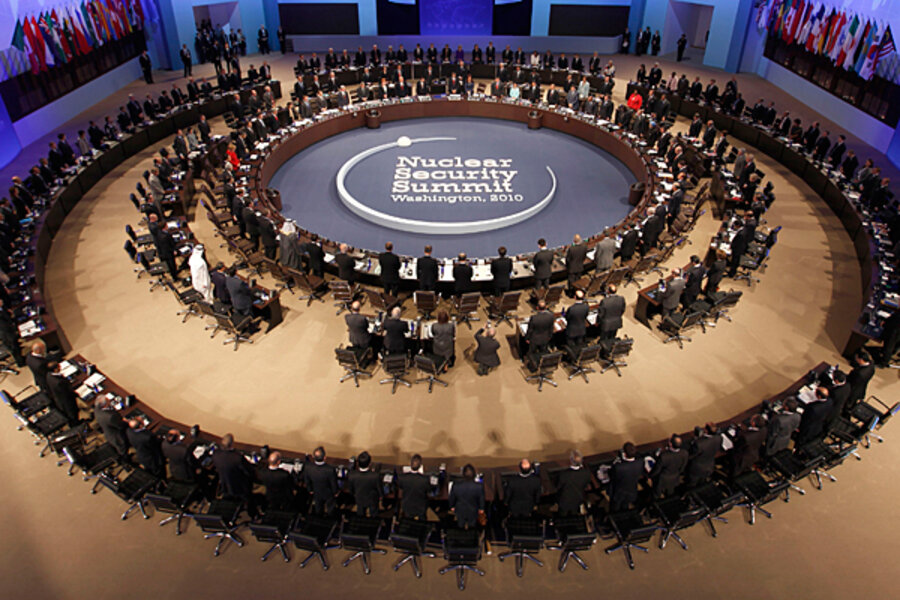Nuclear summit: How much 'loose nukes' material is out there?
Loading...
| Washington
Why is President Obama’s nuclear summit focused on controlling fissile materials? It’s simple: Obtaining enough plutonium or highly enriched uranium is the most important step toward getting a nuclear weapon.
It’s possible that Al Qaeda or some other terrorist group could steal or buy ready-made nukes, of course. But the world’s warheads are relatively secure and accounted for, according to Robert Gallucci, a former US ambassador-at-large for nonproliferation issues.
The stockpiles of fissile materials sprinkled around the globe are another matter.
“I think the chances of Al Qaeda acquiring fissile material and making its own improvised nuclear device are greater than the chances it will get an already-fabricated weapon and detonate that,” said Mr. Galluci, now president of the MacArthur Foundation, in a Monday speech.
Agreements to tighten controls
Mr. Obama’s summit already has produced some agreements intended to help corral the world’s "loose nuke" problem. On Monday, Ukraine, Canada, and Malaysia all agreed to either reduce or tighten controls on their stores of highly enriched uranium. On Tuesday, Mexico made a similar commitment.
But overall, how much loose nuke material is out there? A lot. The nations of the world together have about 1.6 million kilograms of highly enriched uranium (HEU) and about 500,000 kilograms of plutonium, according to data compiled by Harvard’s Belfer Center for Science and International Security.
Simple division shows the magnitude of the threat this stuff portends. It takes only about 25 kilograms of HEU or eight kilograms of plutonium to make a crude nuclear bomb.
Fissile material is held at hundreds of locations, with varying levels of security. There are more than 130 research reactors alone that are powered by HEU, some of them in developing or transitional countries, notes the Belfer Center.
Vietnam, for instance, has at least 5 kilograms of HEU, according to a list compiled by the Institute for Science and International Security. Jamaica has a kilogram. So does Ghana.
Worldwide, many of these locations need better security. Would it be difficult for terrorists to break in and get their hands on fissile material? Not difficult enough.
“The threat looms large,” according to Matthew Bunn, a principal investigator at the Belfer Center.
The greatest threat is in Pakistan, according to Mr. Bunn, which has almost 1 ton of plutonium plus a smaller amount of HEU. Pakistan’s stockpile is well-guarded, but it confronts “immense threats from both insider theft and outsider attack,” according to Bunn.
Terrorist groups known to be seeking fissile material
In the past, Al Qaeda has tried to buy nuclear material on the world black market. So has the Japanese group Aum Shinrikyo, which gained notoriety via its 1995 sarin gas attack on the Tokyo subway.
Other terrorist groups that have shown interest in acquiring a nuclear capability include the South Asian Islamists of Lashkar-e-Taiba and Chechen separatists.
A series of events in recent years has raised the world’s awareness of the loose nukes problem, according to Tanya Ogilvie-White, a senior lecturer at the University of Canterbury in New Zealand and co-author of a US Council on Foreign Relations report on nuclear security.
In 2007, for instance, a group of eight people broke into South Africa’s Pelindaba nuclear reactor and research center.
“They actually got into it, and there was enough nuclear material stored there for about 25 nuclear weapons. Luckily, it was stopped by security services,” said Ms. Ogilvie-White in remarks posted on the Council on Foreign Relations website.
Ogilvie-White says she’s optimistic that the world will move toward taking better care of its loose nuclear material, now that countries have awakened to the extent of the danger.





